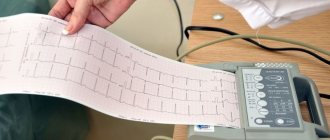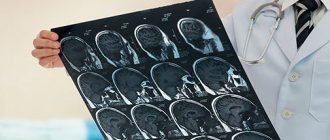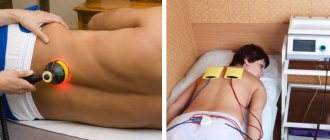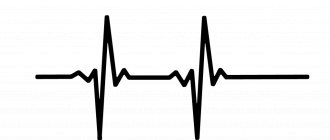Coronary heart disease (CHD)
is a pathological condition in which the heart muscle (myocardium) receives insufficient blood supply.
The heart, like all other organs, must receive the substances necessary for normal functioning, which are delivered by the bloodstream. Fresh blood enters the myocardium through the heart’s own arteries; these are called coronary arteries
.
Narrowing of the lumen of the coronary arteries leads to ischemia (local decrease in blood supply) of the heart muscle. Therefore, coronary heart disease is sometimes called coronary disease
.
Nausea, vomiting in women (including during pregnancy)
Nausea and vomiting, along with a throbbing headache, depressed mood, increased sweating and numbness of the hands, characterize the cephalgic form of premenstrual syndrome (PMS).
At the same time, blood pressure remains within normal limits. Unpleasant symptoms occur 2-10 days before menstrual bleeding in women with irregular cycles, a history of abortion or depression. Considering that the nervous system in women is more excitable than in men, nausea and vomiting during menstruation can be triggered by any unpleasant odor. Often, prolonged nausea without vomiting in women is a consequence of following a strict diet for a long time. The use of dubious food additives, a lack of essential microelements and vitamins, and the abuse of laxatives leads to chronic stress and disruption of the digestive tract. In addition to this, dysbacteriosis develops. The feeling of nausea goes away only after the intestinal microflora is normalized.
Nausea for no apparent reason is often the first sign of pregnancy. The unpleasant sensation is associated with a sharp increase in the level of the hCG hormone. Further hormonal changes in the female body, changes in metabolism and psychological stress often provoke vomiting 1-2 times a day, more often in the morning. The state of health returns to normal by the 13th week of pregnancy.
Early toxicosis (before 16-18 weeks of pregnancy)
- Mild degree - vomiting up to 5 times a day, the condition of the pregnant woman is satisfactory, the fetus is not in danger.
- Early toxicosis of moderate severity - vomiting up to 10 times a day, weight loss up to 3 kg, rapid pulse (up to 100 beats/min), acetone in the urine.
- Excessive vomiting of pregnancy (grade three) - vomiting up to 25 times a day, weight loss of more than 5%, dehydration and electrolyte imbalance. Immediate medical intervention is required.
Important! Severe vomiting in early pregnancy may indicate a hydatidiform mole.
Regularly occurring nausea and vomiting in late pregnancy makes one suspect the development of preeclampsia, the third stage of late toxicosis (preeclampsia). This condition is preceded by the appearance of swelling of the limbs and face (stage 1), increased a/d and protein in the urine (nephropathy, stage 2 of gestosis). Without timely treatment of preeclampsia, seizures (eclampsia) develop and the risk of stroke is high. For the fetus, late toxicosis is fraught with hypoxia, delayed development and perinatal pathologies. There is a high risk of placental abruption and premature birth.
Important! Nausea and vomiting in a pregnant woman can also be caused by taking iron supplements to treat anemia, common gastroenteritis, or another disease.
Nausea and vomiting in children
Frequent regurgitation of infants in most cases is caused by gastroesophageal reflux (reflux of food into the esophagus due to incompetence of the lower sphincter). However, this condition has nothing to do with vomiting. A one-time gag reflex against the background of a normal general condition also does not require special attention. Repeated vomiting in a newborn often indicates illness.
- Pyloric stenosis (manifests at 3-12 weeks) - vomiting “fountain” soon after finishing feeding. Unlike systemic diseases, vomiting with pyloric stenosis does not contain bile, and the baby sucks the breast with appetite.
- Intestinal obstruction - occurs due to intestinal atresia, obstruction of the ileum by extremely viscous meconium (meconium ileus), volvulus, or intestinal stenosis. From the first days the baby suffers from vomiting, and the general condition rapidly deteriorates.
- Intussusception (3-36 months) - often caused by viral enteritis and leads to intestinal obstruction. Attacks of severe abdominal colic and vomiting every 15-20 minutes lead to ischemia of the intestinal area, gangrene and perforation.
Nausea and vomiting in a child can be caused by unusual foods, nervous stress and various odors.
The main causes of vomiting in older children:
- viral/bacterial gastroenteritis - often occurs with diarrhea and fever;
- influenza, acute respiratory infections, childhood infections (for example, scarlet fever) - against the background of a high temperature, the child often develops vomiting and convulsions are possible;
- helminthic infestation - the child complains of nausea without vomiting, the parents note that the child has bad breath, rumbling in the stomach, itching in the anus and grinding of teeth at night;
- errors in nutrition - too fatty, spicy or fried foods provoke nausea, diarrhea and sometimes vomiting without fever;
- appendicitis - pain can begin in the stomach, near the navel or lower in the right side, the child becomes lethargic and drowsy, any painkillers for abdominal pain are strictly prohibited;
- poisoning with drugs and household chemicals - often causes an extremely serious condition, the symptoms depend on the toxic substance;
- sunstroke (heatstroke) - when overheated, the body temperature rises to 40ºC, the skin turns red and sweats significantly, nausea/vomiting and headache occur, breathing and heart rate increase;
- taking antibiotics almost always provokes intestinal dysbiosis (feeling of nausea after eating without vomiting, loss of appetite, constipation/diarrhea). To maintain intestinal microflora, antibacterial courses are combined with the intake of probiotics.
What pathologies need to be excluded first?
Most often, nausea is accompanied by an unpleasant sensation in the epigastric region, stomach or esophagus, and a desire to vomit. Some patients note that they feel dizzy and have heart pain. Nausea is a sign of diseases of various origins; only a doctor can determine the cause. To avoid making an incorrect diagnosis, the entire complex of a person’s symptoms and complaints is taken into account. Below is a list of diseases in which the leading symptoms are nausea and cardialgia:
- Hypertension and a persistent increase in levels of more than 150/100 mmHg. Art., at which severe nausea or vomiting at the peak of pressure, dizziness, and a feeling of noise in the head and ears appear.
- Hypertensive crisis . With a sharp increase in pressure, severe nausea occurs, salivation and weakness in the lower extremities increase, sweating or numbness in the palms, perspiration and sweat on the face, noise and ringing in the head and ears.
- An attack of angina and chest pain of varying intensity is accompanied by weakness, sweating, discomfort in the chest and stomach, mild nausea, fatigue and discomfort in the epigastric region.
- Acute coronary syndrome . It is typical for severe nausea to appear long before a painful attack with a feeling of constriction in the chest, rapid breathing, a feeling of lack of air, panic and fear of death.
- Acute myocardial infarction . In rare cases, sharp pain and cramps in the stomach first appear, which is accompanied by sweating and severe vomiting, regardless of food intake.
- Heart rhythm disorder , in which an irregular, rapid contraction of the heart and pulse is felt as trembling or fluttering in the sternum. Against the background of severe weakness, dizziness and sweating, salivation increases, nausea and vomiting of food eaten the day before appear.
- Compensated heart failure , which causes constant fatigue, loss of strength, headaches and periodic nausea.
- Chronic heart failure in the stage of decompensation. Persistent deterioration of the condition is accompanied by an increase in impotence, shortness of breath, swelling, constant nausea and aching pain in the heart area.
- Myocarditis against the background of ARVI . In the acute phase of the disease, severe shortness of breath, a feeling of tightness in the chest with a lack of air, nausea with periodic vomiting and chills, aggravated by an increase in body temperature, are disturbing. Read more about chest discomfort after a cold here.
- Poisoning with cardiac drugs from the group of cardiac glycosides or acetylsalicylic acid. Nagging pain in the heart and dizziness, hand tremors, nausea and vomiting occur with an overdose of these medications.
Nausea and vomiting with coronavirus
Severe complications and high mortality with COVID-19 force us to more carefully study the first symptoms of the disease. The difficulty lies in the fact that the virus rapidly mutates, and the clinical manifestations of the disease also change. In 2021, typical symptoms of coronavirus infection were fever, loss of smell and taste, muscle pain, and only then a cough. Only some patients experienced nausea and vomiting a little later. In 2021, the majority of cases are caused by the Indian strain of COVID-19, which is characterized by higher infectiousness and a “stomach” syndrome. Against the background of fever and catarrhal symptoms (runny nose, sore throat, cough), every third patient with coronavirus experiences nausea/vomiting and pain in the stomach. A little later, diarrhea and hearing problems appear, and the sense of smell disappears less often.
The "Delta" strain most often affects young people and children. And previously worked out treatment regimens give a noticeably less effect. This is why vaccination of the population, including those who have previously had coronavirus, is so important. Although a two-time vaccination does not completely eliminate infection, it will help avoid severe disease, complications and death. Among the sick, the percentage of vaccinated people does not exceed 1%.
Important! Nausea after vaccination against coronavirus occurs in every tenth vaccinated person. Vomiting is a rare side effect. All unpleasant consequences of the vaccine disappear within 3 days.
Why nausea can accompany heart pain
Complaints that the heart hurts and feel sick indicate a pathology of the cardiovascular or nervous system. The appearance of such symptoms is provoked by many factors. The mechanism for the occurrence of nausea and vomiting is the same. The vomiting center is located in the human brain. Anatomically, it is located in the medulla oblongata, near the respiratory, vasomotor and autonomic centers, and is closely connected with them. Changes in the frequency and rhythm of breathing, increased salivation, increased heart rate and pain in the heart provoke excitation of the vomiting center and precede nausea. The stimulating effect on the vomiting center causes irritation of internal receptors, which occurs when:
- a sharp increase in blood and intracranial pressure;
- heart rhythm disturbances;
- lack of oxygen and reflex effect on the digestive organs during hypoxia;
- increase in intracardiac pressure;
- increased intra-abdominal pressure;
- excessive stretching of the stomach walls by drinking a large amount of liquid or eating food.
Medicines whose metabolites stimulate the cells of the vomiting center also cause nausea.
Cardialgia, pain in the heart in the left half of the chest or in the armpit area signal one of the diseases of the cardiovascular system, which is characterized by a combination of symptoms of aching pain in the organ and nausea. If your health worsens along with the weather, meteosensitivity is most likely to blame. . We described in detail what this is and how to get rid of this problem in the video below.
Specific features of nausea and vomiting
To identify the cause of poor health and assess the patient's condition, the duration of nausea and vomiting is important. Acute vomiting (1-2 days) is often caused by medications, infections, poisoning (such as alcohol), kidney damage, and diabetes. Chronic vomiting (more than 1 week) is characteristic of long-term gastrointestinal diseases and mental disorders.
Features of vomiting and nausea
- Vomiting immediately after eating is characteristic of stomach lesions. If the gag reflex occurs 2-3 hours after eating, pathology of the duodenum is possible.
- Nausea and vomiting of acid are observed with gastritis with increased secretion and stomach ulcers.
- Vomiting of bile (greenish-yellow color) is caused by pathology of the hepatobiliary system (liver, gallbladder) or pancreas.
- Bloody vomit (red or brown) indicates gastrointestinal bleeding.
- Vomiting mucus is characteristic of diseases of the respiratory system (smoker's bronchitis), which occurs with a debilitating cough. Patients with alcoholism often complain of foamy vomiting in the morning (on an empty stomach).
- Vomiting with fever indicates the infectious nature of the disease. With a viral infection, the temperature can reach 39-40ºС. Nausea, vomiting and temperature up to 37.5-37.8ºС are more typical for bacterial infections.
- Vomiting with diarrhea/constipation without fever suggests an intolerance or allergy to certain nutrients, such as lactose.
- Constant nausea without vomiting and fatigue often occur with hypothyroidism.
- Vomiting and pain in the upper abdomen makes it necessary to exclude myocardial infarction, but is more often associated with gastrointestinal pathology.
- Fecal vomiting (dark vomit with a characteristic smell of feces) occurs with intestinal obstruction, tumors, and gastrointestinal fistulas.
Forms of IHD
The main forms of coronary heart disease are:
- angina pectoris. The main manifestation is pain behind the sternum; shortness of breath, sweating, and severe fatigue may also be observed;
- heart rhythm disturbance (arrhythmic form). The most common is atrial fibrillation;
- Myocardial infarction is an acute form of ischemic heart disease. During a heart attack, part of the heart muscle tissue dies (limited necrosis). The reason is complete closure of the artery lumen;
- sudden cardiac arrest (coronary death).
IHD leads to the development of conditions such as post-infarction cardiosclerosis (the growth of connective scar tissue at the site of necrotic lesions) and heart failure (when the heart is unable to provide its “motor” function at the proper level and provide sufficient blood supply). These conditions are also included in the concept of coronary artery disease.
When medical attention is needed
Call an ambulance if nausea/vomiting is accompanied by:
- severe or increasing abdominal pain;
- chest pain;
- high temperature;
- neck muscle tension;
- anuria (lack of urine, less than 100 ml per day);
- confusion, unconsciousness;
- dehydration;
- numbness and paralysis of the limbs, asymmetrical smile and speech problems;
- vomiting feces or blood;
- uncontrollable vomiting.
Make an appointment with a doctor at the First Family Clinic of St. Petersburg if:
- in an infant, vomiting does not stop for 12 hours, in a child under 2 years old - 24 hours, in an adult - more than 2 days;
- nausea and vomiting occur at least once a week for 1 month;
- nausea and vomiting are accompanied by weight loss.
Tactics for helping a patient with nausea or vomiting due to heart pain
Similar symptoms occur in case of poisoning, psychosomatic disorder, or signal cardiac pathology. If nausea and cardialgia occur:
- Calm down, take a comfortable position, remove excess clothing and normalize breathing.
- If there is pain in the heart, a feeling of strong heartbeat, lack of air, headache, nausea and vomiting, call an ambulance.
- While waiting for a doctor, do not take medications on your own.
- First aid - cool compress on the forehead and face, ventilate the room, give the patient water to drink.
- They pay special attention to the condition of pregnant women; if alarming symptoms appear, immediately contact an obstetrician-gynecologist.
Diagnostics
Patient examination
- Assessing the degree of dehydration.
- Determination of symptoms of acute surgical pathology.
- Neurological status, assessment of clarity of consciousness.
Recommended tests
- Blood tests (general, biochemistry, thyroid hormones, sugar levels).
- General urine test and pregnancy test.
- Stool analysis (coprogram, worm eggs, culture).
Recommended Research
- Ultrasound of the abdominal cavity and endoscopy.
- X-ray and colonoscopy.
- CT/MRI of the intestine, brain.
Treatment
Therapeutic tactics depend on the causative disease, the presence of accompanying symptoms of nausea/vomiting and the general condition of the patient.
- Treat dehydration and electrolyte imbalance with oral medications or IV infusions.
- Antiemetics. In severe cases, the use of 5-HT3 receptor antagonists and corticosteroids is acceptable.
- Causative therapy aimed at eliminating the causative disease.
Self-administration of various tablets for nausea/vomiting is not recommended. Only a doctor, after conducting the necessary research, will determine the cause of poor health and prescribe effective and safe treatment.
How to relieve nausea and vomiting at home
- Drink more fluids. The daily intake for adults is 30 ml/kg body weight. It is advisable to use decoctions of chamomile and mint. Drink slowly, in small sips. You should not drink only after bloody vomiting.
- Eat small meals. Food should be warm. Avoid hard, fried, spicy, fatty and sweet foods. But if you experience uncontrollable vomiting, you should refuse to eat.
- If an unconscious patient is vomiting, turn the head to the side to avoid aspiration.
- If you have severe nausea, you should lie down. Open windows for fresh air. Avoid strong odors and other irritants. Do not brush your teeth immediately after eating.
- If you suspect poisoning (vomiting and diarrhea), you can take activated carbon (1 tablet per 10 kg of weight), smecta, phosphalugel or polysorb.
- Measure your blood pressure. If the readings are high, take an antihypertensive drug prescribed by your doctor or call an ambulance.
- For low blood pressure, it is enough to drink a cup of tea or coffee and sniff ammonia.
- For motion sickness, it is permissible to take antihistamines or special medications (for example, Dramamine).
If nausea or vomiting continues for more than 2 days and your general condition is affected, you should consult a doctor. At the First Family Clinic of St. Petersburg, you will undergo all the necessary tests and instrumental studies in order to quickly identify the cause of the disease and prescribe effective treatment.
Literature used in writing
- "Gastroenterology - National Guide" (2008). Authors: Ivashkin V.T., Lapina T.L.
- “Diseases of the digestive system in pregnant women. Gastroenterology" (2011). Author: Eremina E.Yu.
- "Manual of Gastroenterology, Volume 1" (1995). Authors: Komarov F. I., Grebenev A. L.
- “Gastroesophageal reflux disease in children” (2007). Authors: Prokhorova L.I., Davydova A.N.
- “Inflammatory bowel diseases” (a practical guide for doctors, 2012). Author: Sitkin S.
Coronary heart disease: symptoms
What is coronary heart disease?
“Ischemia” translated from Latin means decreased blood flow. Coronary heart disease develops when normal blood flow in the vessels that bring blood to the heart muscle is disrupted. These vessels are called coronary vessels. With the blood flowing through them, the heart muscle receives the oxygen necessary to produce energy. And the heart requires a lot of energy - after all, it performs a colossal job, pumping more than 7 thousand liters of blood per day, and does this constantly throughout our lives. Therefore, a decrease in coronary blood flow is very dangerous - because of it, the full functioning of the heart is disrupted.
Causes of blood flow disorders
- The most common cause is narrowing of one or more blood vessels due to atherosclerosis. In this case, the walls of blood vessels thicken due to the deposition of cholesterol in them - atherosclerotic plaques are formed. They reduce the lumen of the coronary arteries.
- Also, vasoconstriction can be caused by their spasm
Risk factors for developing coronary heart disease
- high blood pressure
- high blood cholesterol
- smoking
- alcohol abuse
- overweight
- low physical activity
- diabetes
- male
- elderly age
- heredity
It should be noted that if we cannot influence the last three of the listed factors, then all the others can be adjusted to one degree or another. This is important both for the prevention of this disease and for improving the prognosis if the disease has already developed.
Variants of manifestation of coronary heart disease
Angina pectoris
Characteristic symptoms:
1. Chest pain. Typical symptoms of pain associated with angina include:
- nature of the pain – squeezing, pressing, pinching
- localization - in the middle of the chest (in the sternum area), pain can spread to the left arm, jaw, under the shoulder blade
- Feeling of heaviness, discomfort in the chest
- Attacks of shortness of breath
The most common symptoms of angina are:
- occur during physical activity or during emotional stress (it is at these moments that the heart muscle’s need for oxygen increases)
- pass with rest or after taking nitroglycerin (or similar drugs - nitromint, isoket)
The appearance of the above symptoms allows one to suspect that a person has angina. To confirm the diagnosis, additional examinations are used, for example, recording an electrocardiogram (ECG) and daily ECG monitoring.
It should be remembered that if the ECG is not performed at the time of the attack, it may be normal. This does not exclude the diagnosis of angina pectoris. To clarify the presence and severity of narrowing of the coronary arteries, the doctor may prescribe coronary angiography. During this study, a contrast agent is injected into the vessels of the heart, which allows you to see them in X-rays and evaluate the presence and degree of narrowing of the lumen.
You should not postpone a visit to the doctor if the symptoms of angina pectoris :
- appeared for the first time (in the first month after the onset of symptoms, the risk of developing myocardial infarction is very high, especially if the correct diagnosis is not made in time and the necessary treatment is not prescribed)
- become more pronounced, become more frequent, occur with less load than before (this indicates the progression of the disease and the risk of complications)
Heart rhythm disturbances
They arise due to changes in the conduction system of the heart against the background of reduced blood supply. Manifests itself in the form of the following symptoms:
- Feeling of heart failure
- Attacks of rapid heartbeat
- Decreased heart rate below normal
Heart failure
This is a condition in which the contractility of the heart decreases and it cannot fully perform its work.
Symptoms:
- Shortness of breath during exercise and when lying down
- Swelling of the legs, more pronounced towards the end of the day
Myocardial infarction
The most dangerous, life-threatening condition that can manifest itself is coronary heart disease. During a heart attack, a blood clot forms on the surface of an atherosclerotic plaque, blocking the lumen of the vessel and disrupting the flow of blood to the heart muscle (myocardium). Due to an acute lack of oxygen, myocardial cells die. This is called a heart attack. The larger the area of damage to the heart muscle, the more severe the patient’s condition.
Symptoms of myocardial infarction:
- Pain in the chest (sternum area), intense, burning. Can spread to the left arm, jaw, under the shoulder blade. Cannot be removed with nitroglycerin.
Pain is the most characteristic symptom of myocardial infarction, but painless forms are also possible (more often in patients with diabetes mellitus and the elderly)
- Sharp weakness
- Cold sweat
- Feeling short of breath, sometimes coughing with foamy sputum
- In some cases:
- Abdominal pain, nausea, vomiting
- Fainting, loss of consciousness (especially in older age)
If symptoms of myocardial infarction appear, you must immediately call an ambulance. The sooner treatment is started, the greater the chance of avoiding massive damage to the heart muscle and life-threatening complications. Patients with a heart attack are hospitalized in specialized departments, where they receive all the necessary care. If treatment is started in a timely manner, the consequences of myocardial infarction may be minimal and the patient has a chance of returning to an active life.
Treatment of coronary artery disease
Effective treatment of the disease requires maximum elimination of risk factors in combination with drug therapy. The medications prescribed by your doctor should be taken regularly. Be sure to monitor blood pressure, pulse, and the presence and severity of symptoms. In some cases, surgical intervention is performed to restore the patency of the affected coronary vessels (stenting, bypass surgery). However, even after surgery, you must take medications, otherwise the disease will progress and new plaques will appear in the vessels.
Coronary heart disease is a serious disease that should not be taken lightly. If its symptoms appear, it is important to consult a doctor in time, who will prescribe the necessary tests and select the optimal treatment. Modern medicine has a large arsenal of means to treat this disease, and with properly prescribed therapy, severe and dangerous complications can be avoided and the opportunity to live a full life can be maintained. This can only be achieved through the joint efforts of the doctor and the patient, a combination of lifestyle changes and regular medication.
Literature:
Clinical recommendations. Stable coronary heart disease. Russian Society of Cardiology 2020
Clinical recommendations. Acute myocardial infarction with ST segment elevation of the electrocardiogram. Russian Society of Cardiology 2020
Martsevich S. Yu. Treatment and prevention of coronary heart disease. //RMJ 2015; 5: 256-258









